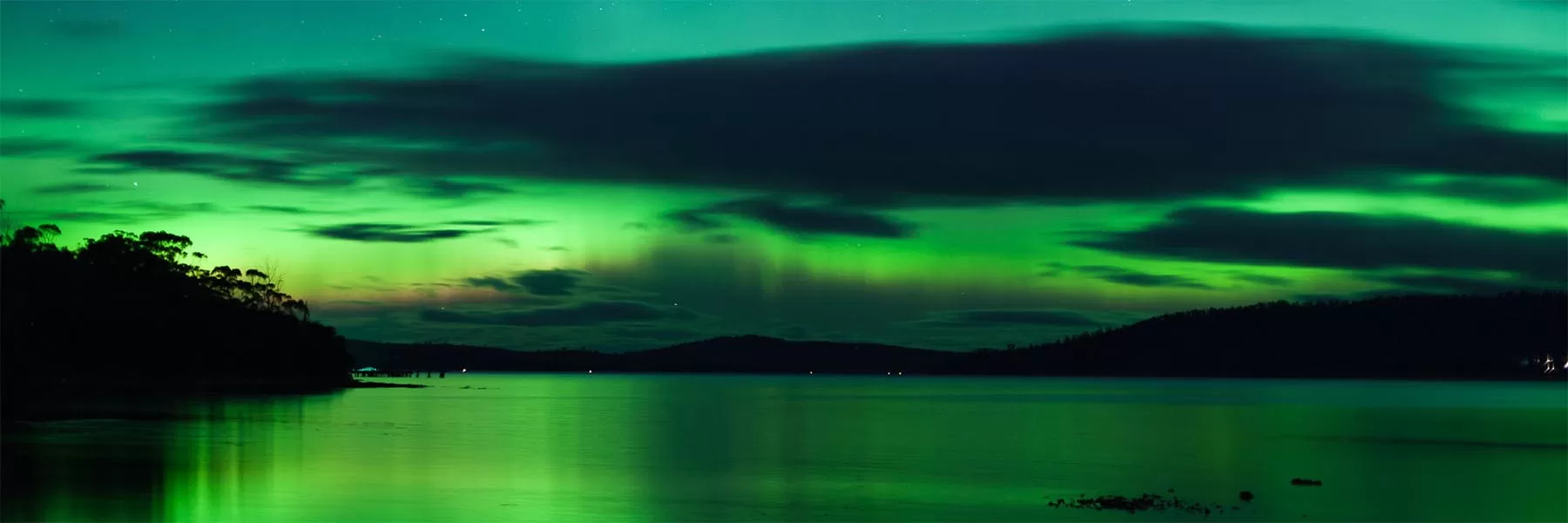Norway’s northern lights get all the attention but did you know it’s equally counterpart Southern lights or Aurora australis is just as spectacular. The southern lights dancing on the hemisphere also deserve an audience and what better place to catch them than in Tasmania.

The beautiful phenomena of Southern lights
Tasmania is a unique island with interesting geology, situated off of the southern coast of Australia. Aside from having species that cannot be found elsewhere in the world, it is also an ideal destination place for many to capture southern lights. And for all the good reasons, Tasmania has been a favorite destination for many tourists as well.
What are the southern lights?
Northern and Southern lights both have the same origin. The process of an Aurora occurs when fully charged particles burst due to the rays of the sun. These particles are then flown to the north and south pole, where you get to see the lights sparkling.
The vivid colors we see are introduced by atoms where green and red represent oxygen while the mixture of blue and green is nitrogen.

Aurora Australis puts on a show in Tasmania
If you’re wondering why northern lights are more talked about, it is because the northern regions have far more vantage points than the south which are easily accessible.
The land down south is very little and comprises more water which makes Aurora australis harder to spot. To catch this phenomenon, you need to be as far down south as possible which makes Tasmania the best destination for it.
Southern lights or Aurora Australis are visible only in the southern hemisphere and the top destination to witness them is none other than Tasmania.
When to expect southern lights in Tasmania?
Since Tasmania has moderate seasonal and daylight changes than other southern destinations, it is an ideal place to see aurora australis. This also results in the lights appearing all year long.
But the best time to observe them is in the winter season, preferably from June to August. As these months are the darkest in Tasmania, there are higher chances to capture southern lights. Winter also has the longest nights, opening plentiful opportunities to catch the southern lights in Tasmania.

People watching the southern lights by a beach in Tasmania
The weather may be unpredictable despite the weather apps saying otherwise because the lights are ultimately decided by the sun. To keep up with southern lights’ real-time sightings, apps such as Star Walk and Solar monitor will help in keeping yourself updated with the weather.
How to capture Tasmania’s Southern lights?
What you see online isn’t how you would view Aurora Australis when they occur. Instead of the red, green, and blue lights dancing overhead, you might only catch glimpses of white flickering lights with your naked eye. The reason for this is because our eyes aren’t meant to capture colors in the night.

Viewing the southern lights with a telescope
Thus, the best way to see them is by photographing the phenomena as they become vivid in the camera.
- Get an SLR camera and a tripod to ensure a stable and clear image.
- Set the camera on manual mode and seek out a wide lens to allow maximum light into the camera. Choose the highest ISO between 800 to 3200.
- The shutter speed should be 5 to 15 seconds and the focus should be set to infinity.
Best spots to see southern lights in Tasmania
Northern lights aren’t as commercialized as the southern so there aren’t particular fixed spots for viewing the lights. However, since Tasmania is an unpolluted island with an open sky, you can see southern lights quite easily.
The top 5 places mentioned in the list below are closest to Tasmania’s capital city, Hobart. Through this, you can also calculate the distance from your original destination.
Remember to dress as warm as possible as the higher altitude and alpine woods may become chilly at night.
1. Hobart
Being the largest city, Hobart has some of the best places to views Tasmania’s southern lights. You will need to find the darkest part of the city to be able to witness the phenomena properly. Some of the best spots in Hobart for southern lights are as follows:
- Howrah beach – This beach has south-facing views, making the lights appear evident.
- Seven Mile beach – Situated near Hobart International Airport, this beach offers light protection and a great place to catch the aurora.
- Rosy Hill – This is a golf course that offers protection from light pollution and makes the southern lights appear brighter.

2. Mount Nelson
Mount Nelson offers the best spot to see a particular stronger and brighter aurora in Hobart city. For the best view, you can head to the top of Mount Nelson to Signal station.

Mount Nelson in the day
This will provide panoramic views of the city as well as the dancing lights. The hill is an easy-ten-minute drive from the city and usually has a small crowd of onlookers.
3. Mount Wellington
One of the best aurora viewpoints is Mount Wellington in the area. The mountain towers at a range of 4000 feet or 1200 meters in elevation, where you can avoid light pollution.

Southern lights dancing over Mount Wellington
Mount Wellington is a 30-minute drive away and is located west of Hobart.
4. South Arm Peninsula
This peninsula is a paradise for astrophotographers and photographers alike. The wide bay in South Arm Peninsula offers an expansive view and the shots captured on camera are incredible.

The southern arm peninsula shining with Aurora Australis
Clifton and Calvert near the peninsula are excellent places for seeing the southern lights as both offer great south-facing views.
South arm peninsula is a 40-minute drive from east and south of Hobart.
5. Cockle Creek
The most recommended destination to catch aurora in action is Cockle creek. Cockle Creek is located at the southernmost point of Tasmania. It is a remote place filled with beauty and peace.

The Cockle Creek located at the southernmost part of Tasmania
The creek is a two-hour drive from the south of Hobart and the nearest accommodation in Ida Bay. Several other cottage inns and rooms can be found to spend a night or two.
The phenomena of Southern lights are exciting and unique in their way. While heading down south, remember to keep these places in mind to capture the most perfect Aurora australis in Tasmania.
If you loved reading this story, then subscribe to our blog here (it will ask to verify your email) to get inspiring travel stories and trivia delivered to your email. Stories about wildlife trivia, cultural experiences, curated luxury hotel lists, underrated places to travel, polar journeys and much more.











